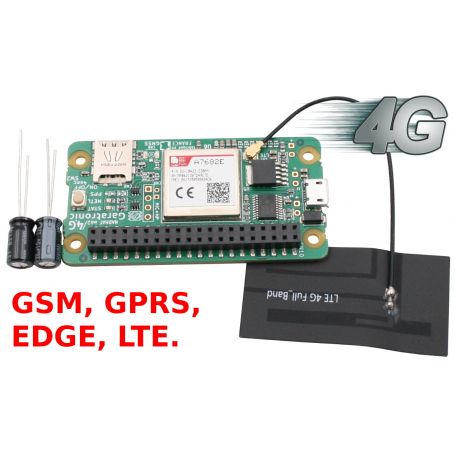Nadhat GSM MK2 - 4G / LTE - USB & HAT - SimCom A7682E
Module GSM 4G / LTE
- Connector: USB or GPIO
- Interface: UART, USB, Mic., Audio out
- Network: GSM/GPRS, Edge, LTE.
- AT command
- Nano SIM
Payments are secured by LyraCollect, a French payment collection company.
It is possible to delivered to your home, to a pick-up point or picked up by appointment at MCHobby
We prepare, pack and ship your orders with great respect and care.
Bring your Raspberry-Pi/microcontroler project to 3G/4G/LTE communication network
Here is the next generation of NADHAT GSM board made by our friend Garatronic.
The Nadhat GSM Mk2 (or Nadhat 4G if you prefer) is aim tp be used with existing GSM/Mobile networks as well as with the newer network designed for IoT network (namely, the LTE network).
This board use the SIMCOM A7682E module which is designed to get connected with GSM/GPRS, EDGE, LTE mobile networks.
Fitted with an USB and UART/GPIO connectors, this GSM module can be plug directly onto the Raspberry-Pi GPIO (with a limited transfer rate) but aussi with USB (for enhanced tranfer rate).
This modiule is simple to use: once plugged (USB or GPIO) it is automaticaly detected and added to the usable device of the computer. Please, note that the modemanager must be uninstalled under Linux.
Please: note that this module is designed for Raspberry-Pi. So we cannot certify this module for Windows or Mac.
Automatic start
The module is designed for automatic startup. The C8 capacitor is used to send the required pulse when the module is set put under power.
It is possible to get rid of this feature by remoding the C8 capacity (See product images).
Dual USB2.0 & UART connector
The UART (on GPIO) is used to establish communication with the SimCom module.
The UART is available on the GPIO port which allow the Raspberry-Pi (or a microcontroler) to communicates with the GSM module.
The USB 2.0 port (microUSB connector) opens 3 USB2.0 connexions with the host (Raspberry-Pi or computer). One of the USB connexions is a Serial-over-USB.
So USB can also be used to sent AT commands over the USB-Serial.
The interest about this USB connexion is to:
- have a larger bandwidth between the computer/raspberry-pi and the 4G module.
- allow an Ethernet connectivity via the GSM module (a Linux computer will automaticaly configure the interface).
Transfer rate?
The transfer rate depend on the mobile network connector to AS WELL AS the interface used between the computer and the SimCOM module. The UART interface (over the GPIO) allows 115200 bauds, this will be a bottleneck in communication. Also wiring the USB to the Raspberry-Pi and you will benefits from the USB2.0 bandwith to transfer the data between the 4G module and the i.
The connected mobile network would have its own transfer rate limitation:
GSM/GPRS
- 36.2 Kb/s (upload/download)
EDGE
- 35.2 Kb/s Max (upload/download, Modulation GMSK)
- 89.6 Kb/s Max (upload/download, Modulation 8PSK)
LTE
- Download: 10 Mbps (peak)
- Upload: 5 Mbps (peak)
Linux and ModemManager
If you are using a Linux type computer then you must uninstall the modemmanager, if you are programming with MicroPython or Arduino then you certainly have done it.
Technical details
- A7682E Hardware Design Manual (pdf, anglais)
- A76XX series AT Command (pdf, anglais)
- Page fabriquant SimCom A7682E (anglais)
Content
For each order you will receive The NadHat 4G board + antenna + 2x 200µF capacitor. Raspberry-Pi, USB cable, etc are not included.
Connecting to the mobile network may require extra power (depending on the distance to the network antenna). If the modem can't connect the network with ease then solder the two caps on the board (they will accumulate the extra power to setup the initial connexion).
Legal documents
- CE Certificate Chipset (SimCom, Anglais)
- CE declaration Nadhat MK2 (garatronic)
- ROHS (Garatronic)
- Raspberry Compatibility
- Zero / Zero W, Pi 3A, Pi 3B+, Pi 4, Pi 5, Zero 2 W, Pi 400
- Interface : Connector
- HAT (RPi GPIO)











